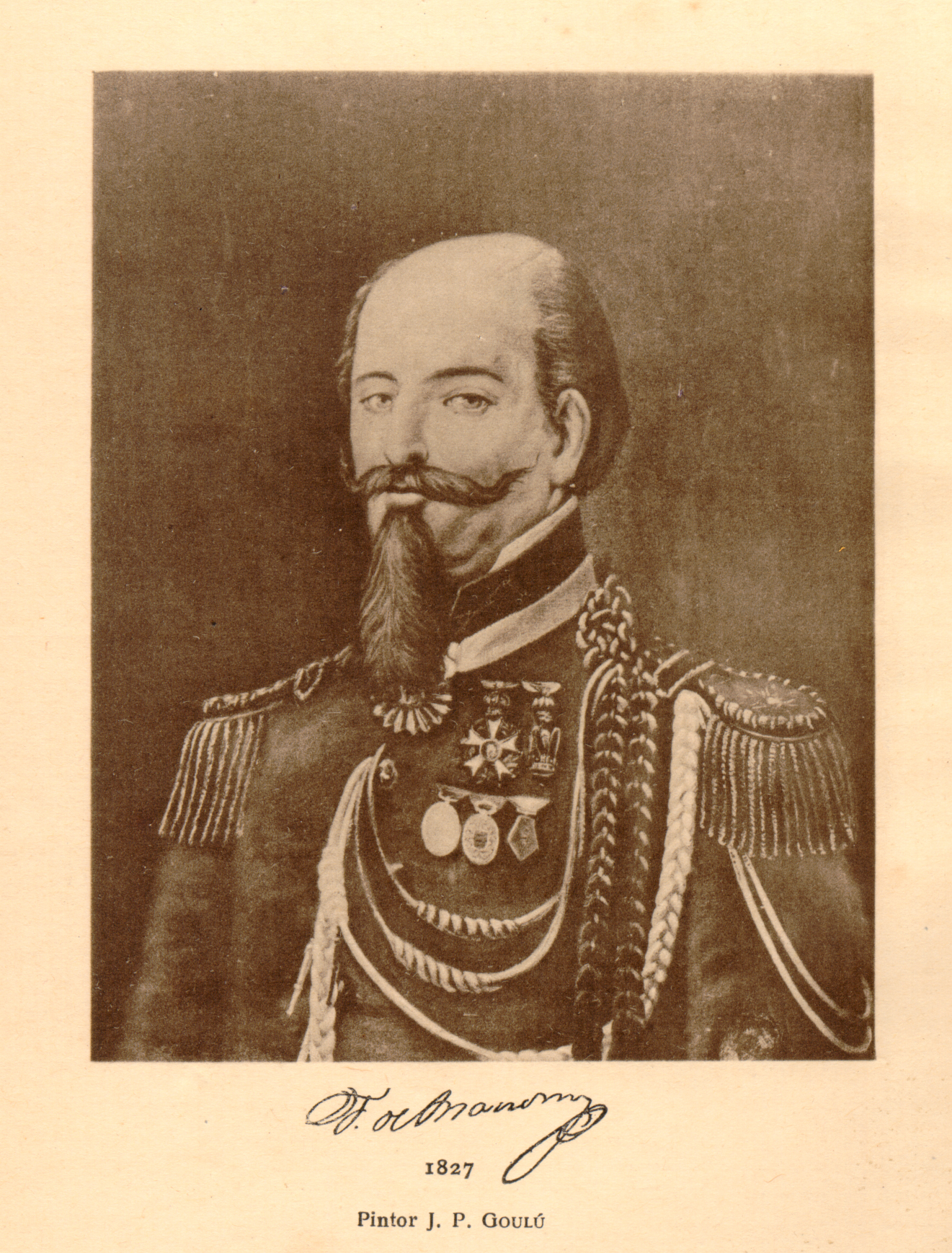- Federico de Brandsen
Infobox Person
name=Federico de Brandsen
caption=
birth_date=birth date|1785|11|28|mf=y
dead=dead
birth_place=Paris ,France
death_date=death date and age|1827|2|20|1785|11|28|mf=y
death_place=Ituzaingó,Uruguay Carlos Luis Federico de Brandsen [sometimes written Brandtzen or Brandzen. The surname is of Dutch origin and the correct form is Brandsen (Salas 1909, pág. 9)] (
Paris ,November 28 1785 -Battle of Ituzaingó ,February 20 1827 ) [Salas, 1909] was a Coronel of French origin who fought in many of the South American wars of independence and forArgentina in the War with Brazil [de Gandía, 1962] .Napoleonic Wars
In 1811 Brandsen joined the Army of the Italian Kingdom who fought alongside Napoleon In the Germany campaign he was injured in three separate battles and gained the rank of captain. After the abdication of Napoleon in 1813 and the dissolution of the Italian Kingdom in 1814, Brandsen returned to France where he fought in the
Hundred Days , receiving another injury.Liberation of Chile and Peru
In 1817 the
Napoleonic Wars ended. Thus, Brandsen was convinced by the Argentine PresidentBernardino Rivadavia to join the fight to liberate the Americas from theSpanish Empire and embarked forBuenos Aires . OnDecember 19 1817 theUnited Provinces of South America gave him the rank of Captain of the , he then fought in theChilean War of Independence under the command of General San Martín. Brandsen then fought in the Bío-Bío campaign and the "Expedición Libertadora del Perú". In the battle of Nazca he distinguished himself alongside MajorJuan Lavalle . OnNovember 8 1820 inChancay he fought valiantly with a group of 36 men against a force of around 200; after this battle he was made Sargent Major.When San Martín became Protector of Peru, Brandsen was named leader of the regiment of Hussars of the Peruvian Legion of the Guard, with the rank of lieutenant Colonel. San Martin had great affection for Brandsen with whom he maintained frequent correspondence. Brandsen was promoted to colonel on
September 17 1822 . He commanded his regiment to a victory inZepita , and as general commander of the Cavalry of the Vanguard of the Army of Peru he fought atSica-Sica andAyo-Ayo holding up the hostile pursuit and saving the remainders of the army defeated in those encounters. In 1822 and 1823 he participated actively in the operations against the royal forces.At the end of 1823 he took the side of President
José de la Riva Agüero in the dispute withAntonio José de Sucre . De la Riva Agüero was promoted to Brigadier General, but with the dissolution of the army that followed him. Brandsen was put in prison and thenSimón Bolívar gave the order for his exile. This order was later rescinded but Brandsen and his wife had already embarked to Chile.War with Brazil
At the beginning of March 1825 he embarked with his family on a ship called "Livonia" destined for Chile. After a brief stay in Santiago he returned to the
Río de la Plata where the government made him the leader of the 1st Cavalry Regiment with the rank of Lieutenant Colonel. OnFebruary 20 1827 in theBattle of Ituzaingó his regiment was faced to the Brazilian infantry occupying a fortified position protected by a deep deep ditch. GeneralCarlos María de Alvear , ordered him to attack head-on, but Brandsen told him that success was impossible in those conditions. Alvear did not accept his prudent arguments and he charged at the head of his troops, dying heroically. The attack failed, but the battle was won because other colonels such as Tomás de Iriarte, Miguel Estanislao Soler and José María Paz, amended the errors of Alvear. Brandsen was posthumously promoted to Colonel; his remains rest in theCementerio de la Recoleta , in Buenos Aires, in front of the mausoleum of General Alvear.Legacy
The city of
Brandsen and the administrative districtBrandsen Partido are named in his honour, there is also a tank regiment named after him and numerous streets in Argentina bear his name.References
Bibliography
*Aubin, José María. "Anecdotario argentino". Buenos Aires: 1910.
*De Gandia, Enrique. "Memorias del General Iriarte". Buenos Aires: Compañía General Fabril Editora, 1962.
*Salas. Carlos I. "Biografía del Coronel Don Federico Brandsen 1785-1827". Buenos Aires: Compañía Sudamericana de Billetes de Banco, 1909.
*Santa Coloma Brandsen, Federico. "Escritos del Coronel Don Federico de Brandsen". Buenos Aires: Compañía Sudamericana de Billetes de Banco, 1910.External links
* [http://www.caballeria.ejercito.mil.ar/Rctan1/index2.htm "Coronel Federico Brandsen" 1st tank regiment]
Wikimedia Foundation. 2010.
